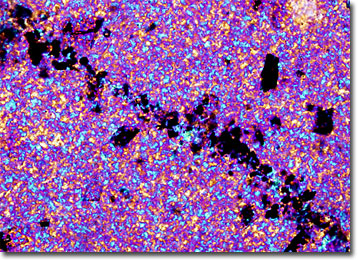Polarized Light Microscopy Digital Image Gallery
Novaculite
Novaculite is a very hard, dense type of sedimentary rock often described as a type of bedded chert. Primarily composed of microcrystalline quartz, novaculite has a long history of use in North America.

Relatively rare, only rock formations found in Texas, Oklahoma, and Arkansas are usually described as novaculite. The term derives from the Latin novacula, meaning “sharp knife” or “razor stone.” Such etymological roots are indicative of the sharpness of the edges of the rock when it has been chipped. Indeed, it was for the razor-like spearheads, dart points, and arrowheads that could be formed from the material that Native Americans primarily utilized the rock. Evidence suggests that tribes in North America began quarrying novaculite in Arkansas for such purposes as early as 3,000 years ago. In addition to local use, the stone was shipped to a number of outlying areas and traded throughout the Lower Mississippi Valley.
Early Europeans that traveled to North America to establish settlements soon realized the value of novaculite as a whetstone, and records indicate that their mining efforts of the siliceous rock were well underway by the early 1800s. These newcomers also utilized novaculite as an abrasive, an application for which it is still often utilized today. Despite significant demand for the rock and its occurrence in only a few locations, supplies remain strong. This is primarily because of the sizable masses in which it occurs, most of which are believed to have been formed during Mississippian and Devonian ages. Resistant to erosion, novaculite remains unaltered in locales where other rocks have worn away, forming prominent ridges and outcrops in areas such as the Ouachita Mountains.
